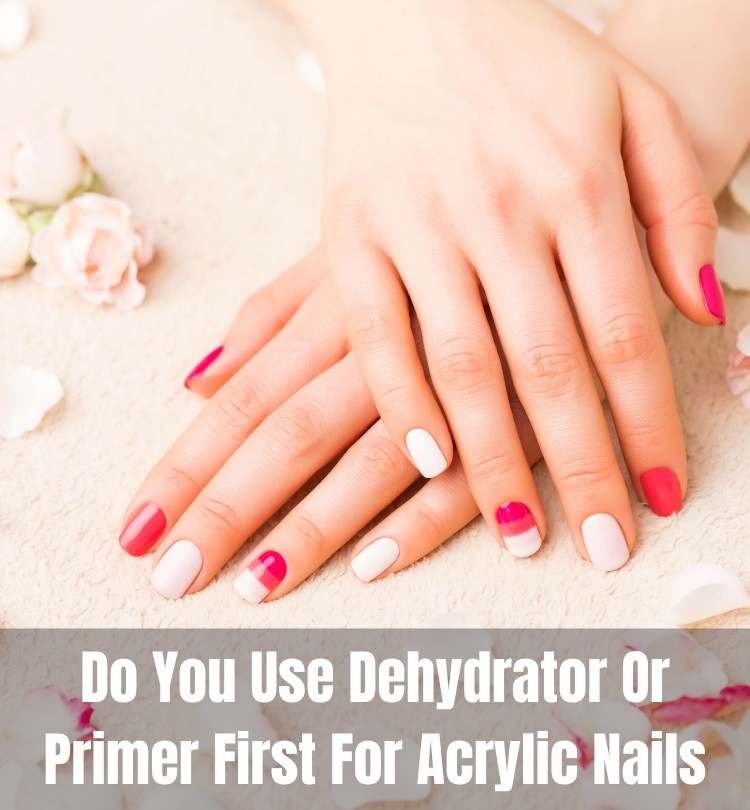Picture this: You’re staring into your nail polish collection, a vision of perfectly sculpted acrylics swirling in your head. The only thing standing between you and those gorgeous, long nails is the question that’s plagued countless nail enthusiasts: do you use dehydrator or primer first? It feels like a tricky riddle, and the wrong answer could mean weak, peeling acrylics instead of the masterpiece you envisioned.

Image: www.theapexbeauty.com
Fear not, nail aficionados! This guide dives deep into the world of acrylic preparation, revealing the secret to a flawless acrylic application. We’ll break down the roles of dehydrator and primer, explain the science behind why order matters, and give you all the tips you need for a flawless finish that lasts.
The Foundation of a Flawless Acrylic: Understanding Dehydrator and Primer
Before we tackle the order of operations, let’s clarify the purpose of each product:
Dehydrator: Think of it as your nail’s personal hydration expert, but in reverse! Dehydrators are formulated to remove excess moisture and oil from the nail plate, creating a perfectly dry and clean surface. This is crucial for the next step, as a moist nail can prevent the acrylic from adhering properly.
Primer: This is the glue that bonds everything together. Primers act like a bridge between the natural nail and the acrylic, creating a strong and lasting connection. There are two main types of primers:
- Acid-based: These primers contain a mild acid that roughens the nail surface, allowing for maximum adhesion. They’re very effective but can be harsh on the nail if used incorrectly.
- Non-acid: These primers use gentler chemicals to create a bond, making them a more suitable choice for sensitive nails. They may not be as strong as acid-based primers, but they provide excellent adhesion.
The Debate: Dehydrator vs. Primer – Why Order Matters
The order in which you apply dehydrator and primer is crucial for a long-lasting acrylic manicure. Here’s why:
- Dehydrator: The First Step to Success: Dehydrator acts as a pre-treatment, ensuring the nail plate is completely dry before primer application. Imagine trying to glue wet paper together; it wouldn’t stick! The same principle applies to acrylics.
- Primer: The Bonding Agent: Once your nail is completely dehydrated, you’re ready to apply primer. This is the bonding agent that forms the foundation for your acrylics. A properly dehydrated nail allows for a strong bond, minimizing the risk of lifting or peeling.
Common Mistakes and Their Consequences
Using the wrong order or skipping these steps altogether can lead to several frustrating outcomes:
- Lifting: Acrylic nails lifting from the nail plate is a common issue that stems from improper prep. It happens when the nail is moist, and the primer doesn’t create a strong bond.
- Peeling: Acrylic nails that peel are another sign of weak adhesion. A properly dehydrated nail ensures the primer adheres correctly, minimizing the chances of peeling.
Important Note: Always follow the manufacturer’s instructions for each product. Some brands recommend using a dehydrator before primer, while others offer combined products. Read the labels carefully!
![Should I Use Nail Primer Or Dehydrator First? [Answered]](https://www.bodycarevault.com/wp-content/uploads/2022/07/nail-primer-or-dehydrator-first-2-1024x683.jpg)
Image: www.bodycarevault.com
Expert Insights and Actionable Tips from Experienced Nail Technicians
Nail technicians have seen it all! They understand the importance of proper acrylic preparation. Here are some insider tips from the pros:
- Invest in Quality Products: Don’t skimp on dehydrator and primer. Choose high-quality products from reputable brands.
- Always Apply Dehydrator First: This is a universal rule for creating a strong foundation.
- Use Gentle Motions: Avoid over-dehydrating the nail. Gentle swiping motions are all you need.
- Let the Dehydrator Dry Completely: Don’t rush! Allow the dehydrator to air dry fully before applying primer.
- Use Primer Sparingly: A thin, even coat is all you need. Too much primer can weaken the bond.
Nail Prep: A Step by Step Guide
To make things crystal clear, we’ve put together a step-by-step guide to proper nail preparation for acrylics:
- Cleanse your nails: Start by using a lint-free wipe soaked in acetone to remove any traces of polish, oil, or residue.
- Dehydrate your nails: Apply a thin coat of dehydrator to each nail, making sure to cover the entire surface. Allow the dehydrator to dry completely before moving to the next step.
- Apply primer: Using a small primer brush, apply a thin, even coat to each nail. Avoid getting primer on the skin, as it can irritate.
- Let the primer dry: Allow the primer to air dry completely before starting the acrylic application.
- Apply acrylic: Now you’re ready for the fun part! Using your desired acrylic powder and liquid monomer, shape and sculpt your acrylic nails.
Do You Use Dehydrator Or Primer First For Acrylic Nails
Conclusion: The Key to a Durable Acrylic Manicure
Remember, taking the time to properly prepare your nails is the key to achieving a stunning and durable acrylic manicure. Always use a dehydrator first, followed by a primer. Stick to high-quality products and follow the instructions for a flawless finish that lasts. Now go forth and create your own nail masterpieces! Share your tips and experiences in the comments below!





